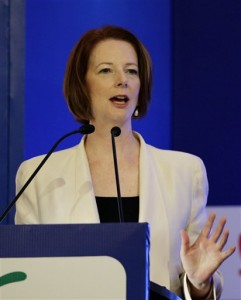Ambitious Asia plan to power Australia—PM

Australian Prime Minister Julia Gillard: Our future will be determined by the choices we make and how we engage with the region we live in. AP PHOTO
SYDNEY—An ambitious plan aimed at maximizing links with booming China and other soaring Asian economies will power Australia into the world’s top 10 wealthiest nations by 2025, the government said Sunday.
The sweeping policy blueprint, titled “Australia in the Asian Century,” sets a series of goals for the next 13 years to seize upon Asia’s rapid ascent as a global economic powerhouse led by the modernization of China and India.
“The scale and pace of Asia’s rise is staggering, and there are significant opportunities and challenges,” Prime Minister Julia Gillard said.
Gillard said Australians had long seen Asia as a threat “racially, militarily and economically” but the region had changed dramatically in the past 30 years, demanding “new changes of us today.”
“It is not enough to rely on luck – our future will be determined by the choices we make and how we engage with the region we live in.”
Article continues after this advertisementBy 2025, Gillard said Australia’s GDP per person – a measure of personal wealth – would jump into the world’s top 10, joining the likes of Qatar, Singapore, Hong Kong, Brunei, the United Arab Emirates and the United States.
Article continues after this advertisementIt is currently ranked 13th according to the International Monetary Fund, which calculates the gauge by dividing goods and services produced by a country by its population and adjusting for relative cost of living and inflation.
Australia dodged recession during the financial crisis due to its links to Asia but the mining-powered economy slashed its growth and surplus forecasts last week as China’s slowdown hits commodity prices.
Gillard said her vision was for Australia to “stand strongly as a mature and confident power” in the region, supporting greater participation by China and other Asian powers in decision-making while remaining a key US ally.
“We are supporting the stabilizing presence of the United States, a strong defense force, building habits of trust and cooperation in our region and a rules-based regional order,” she said.
Gillard said China, India, Indonesia, Japan, South Korea and the US would be Australia’s key partners, and the rise of Asia’s middle classes would bring opportunities in industries from health and aged care to food and travel.
One-third of Australia’s economy would be underpinned by trade with Asia, up from one-quarter today, and it would be one of the world’s top five countries to do business in, she added.
Education and business were key areas for goal-setting – by 2025 Gillard said Australia’s school system would be in the top five and it would have 10 of the world’s 100 best universities.
Studies of Asia would be a core part of the national curriculum and Mandarin, Hindi, Indonesian and Japanese were to be “priority” languages.
Treasurer Wayne Swan said the Asian region would soon be the world’s largest production and consumption zone and was set to overtake the economic output of Europe and North America combined by the end of this decade.
Average personal wealth in Asia was set to double by 2025 and even the most conservative projections predict four of the world’s 10 largest economies will be in Asia by then, Swan said.